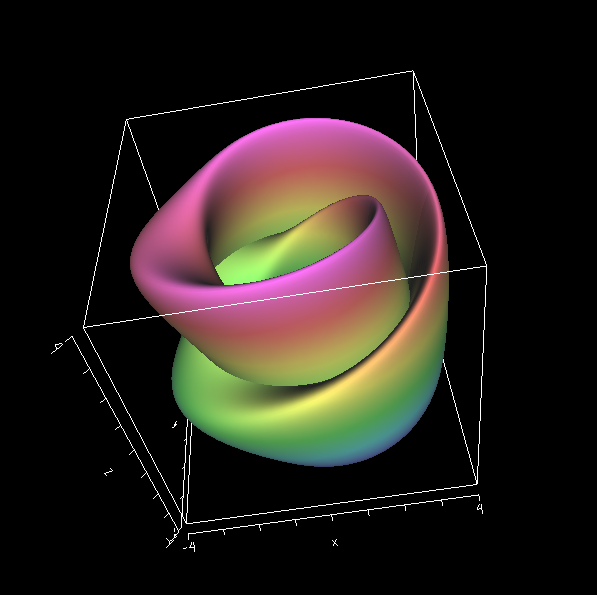<!DOCTYPE html PUBLIC "-//W3C//DTD HTML 4.01 Transitional//EN">
<html>
<head>
<meta content="text/html;charset=ISO-8859-1" http-equiv="Content-Type">
</head>
<body bgcolor="#ffffff" text="#333399">
<font size="-1"><font face="Helvetica, Arial, sans-serif">Don,<br>
<br>
Well, I'm sure glad I asked that question. I
previously thought
the GriddedNDSet was the same as the LinearNDSet except with irregular
spacing. It's amazing how much you can miss just reading the JavaDoc
and technical references. In any event, whether my mind is fully
"wrapped around it" or not, my understanding has greatly increased.
Attached is a Figure 8 Klein Bottle using the Gridded3DSet with
manifold dimension = 2 as proof. I attached it to see if that solves
the email problem I was having. ;-)<br>
<br>
I was also confused about the manifold
dimension. There appear to
be two dimensions, the domain dimension and the manifold dimension.
The domain is also a manifold (or can be) I think, and that is what I
thought was meant by manifold dimension.<br>
<br>
I found the following reference helpful, although it
is a bit
terse and missing the figures:<br>
<br>
<a class="moz-txt-link-freetext"
href="http://www.unidata.ucar.edu/staff/caron/papers/CoordMath.htm";>http://www.unidata.ucar.edu/staff/caron/papers/CoordMath.htm</a><br>
<br>
Thanks for the help and information,<br>
<br>
-Ken<br>
</font></font><br>
Don Murray wrote:
<blockquote cite="mid460AD2B5.7010305@xxxxxxxxxxxxxxxx" type="cite">Hi
Ken-
<br>
<br>
It is all very confusing, but once you wrap your mind around
<br>
it, it's an incredibly powerful and flexible data model.
<br>
<br>
Here's the way I try to think of it. A domain can have a dimension
<br>
(number of components of the RealTupleType) and a manifold dimesion
<br>
(the structure of that data). For a given manifold dimension:
<br>
<br>
1 = line
<br>
2 = plane
<br>
3 = volume
<br>
<br>
That's an oversimplification, but it's how I rationalize what
<br>
to use.
<br>
<br>
So a Gridded2DSet (dim=2) with a manifold dimension = 1 is useful
<br>
for depicting things like map lines. The points have 2 dimensions
<br>
(lat,lon), but the single manifold dimension gives them the
<br>
structure of lines connecting the points. A Gridded3DSet on a
<br>
2D manifold would be a slice through a volume (i.e. a plane).
<br>
<br>
A LinearNDSet inherently has the same manifold dimension as
<br>
its domain dimension, thus you can't use it to depict a crosshair
<br>
which is a 2 or 3D set on a 1D manifold.
<br>
<br>
As for wrapping your head around this all, at Unidata we say that
<br>
when you can say from memory (paraphrased from the FlatField javadoc):
<br>
<br>
A FlatField range type may be either a RealType, a RealTupleType, or a
TupleType of RealType-s and RealTupleType-s.
<br>
<br>
AND understand it, you'll have reached that VisAD enlightenment. ;-)
<br>
<br>
Don
<br>
<br>
Kenneth Evans wrote:
<br>
<blockquote type="cite"> It is more that it is
counterintuitive
to me to be using ((x,y,z) -> t) rather than (t -> (x,y,z)).
However, I guess the same thing appears on the plot. The reason for
reversing the order seems to be to get the correct topology. So I now
have a recipe, but I am not sure I understand what is happening. Is it
written up somewhere what has and doesn't have a topology and what that
topology is. I haven't come across it.
<br>
<br>
It is also interesting about the manifold dimension =
1. It seems
to me that the domain, which is the part that goes with the
Gridded3DSet, has manifold dimension = 3, and that it is the range that
has manifold dimension = 1. (When using your order.) Or am I just
confused.
<br>
<br>
I did try to make a cursor consisting of two crossed lines
recently. I noticed that I needed to use a Gridded2DSet, whereas a
Linear2D set should have served. I believe the later gave points, not
lines. I assume this is the same problem. (I ended up using a
shape.)
<br>
<br>
Thanks for the information,
<br>
</blockquote>
<br>
*************************************************************
<br>
Don
Murray
UCAR Unidata Program
<br>
<a class="moz-txt-link-abbreviated"
href="mailto:dmurray@xxxxxxxxxxxxxxxx";>dmurray@xxxxxxxxxxxxxxxx</a>
P.O. Box 3000
<br>
(303)
497-8628
Boulder, CO 80307
<br>
<a class="moz-txt-link-freetext"
href="http://www.unidata.ucar.edu/staff/donm";>http://www.unidata.ucar.edu/staff/donm</a>
<br>
*************************************************************
<br>
<br>
<br>
==============================================================================
<br>
To unsubscribe visad, visit:
<br>
<a class="moz-txt-link-freetext"
href="http://www.unidata.ucar.edu/mailing-list-delete-form.html";>http://www.unidata.ucar.edu/mailing-list-delete-form.html</a>
<br>
==============================================================================
<br>
<br>
</blockquote>
</body>
</html>
